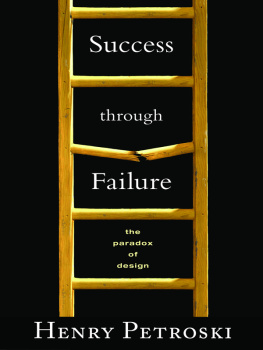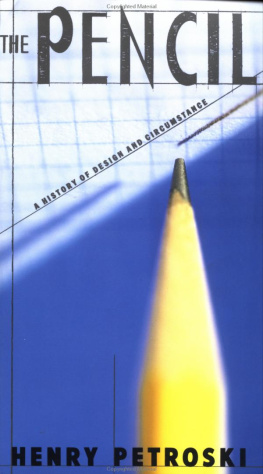Force
Force
What It Means to Push and Pull, Slip and Grip, Start and Stop
Henry Petroski

Copyright 2022 by Henry Petroski. All rights reserved. This book may not be reproduced, in whole or in part, including illustrations, in any form (beyond that copying permitted by Sections 107 and 108 of the U.S. Copyright Law and except by reviewers for the public press), without written permission from the publishers.
Yale University Press books may be purchased in quantity for educational, business, or promotional use. For information, please e-mail (U.K. office).
Set in Galliard Old Style with Gotham Medium type by Integrated Publishing Solutions. Printed in the United States of America.
Library of Congress Control Number: 2021950015
ISBN 978-0-300-26079-3 (hardcover : alk. paper)
A catalogue record for this book is available from the British Library.
This paper meets the requirements of ANSI/NISO Z39.48-1992 (Permanence of Paper).
To Theodore James
No force however great
can stretch a cord however fine
into an horizontal line
that is accurately straight
William Whewell
An Elementary Treatise
on Mechanics, 1819
Contents
Preface
This is a book about force, the everyday physical interaction between ordinary thingsincluding peoplethat enables them to stay in place or causes them to move. It is the force of daily human experience, whereby we feel the sensations of push and pull, weight and buoyancy, resistance and assistance, achievement and defeat. It is the force we fight in climbing a mountain, swimming against the tide, doing heavy lifting, trying to open a bag of peanuts. It is the force that enables us to walk and airplanes to fly. It is the force we feel through a cars bouncing, swerving, swaying, and cornering. It is the physical force by means of which we do everything from raising a cup of coffee to opening a jar of jam. Without forces and their effects, we would lose contact with our world.
Thinking about how we experience force in the context of our everyday activities, we can begin to understand its nature and appreciate how it has been harnessed for our use and pleasure. Force is also a physical link between human beings. The feel of a handshakewhether a firm grip or a dead fishtells us about the personality and mood of strangers and old friends alike. An open hand may give us an encouraging pat on the back; a clenched fist, a punch in the gut. Through the tender touch of a finger, the soft caress of an arm, or the peck of a kiss, we can convey to another a sense of safety, comfort, and love. Although forces of contact may be mechanical phenomena, in human hands they can be the stuff of war and peace.
Forces themselves may be invisible to the eye, but they are sensible to the touch. Although we experience this countless times as we go through our daily routine, it has become so familiar that we seldom stop to reflect upon it, which is why I have written this book. In it, I have focused not so much on physics as on the physical. I have tried to capture in words what I feel with my senses. I believe everyone already does feel the forces I describe herein; I want to encourage readers to feel them more intensely and appreciate them more broadly in the context of living. There are many ordinary activities in which we engage that involve background forces of which we may not even have been aware. I bring these to the forefront to reveal what we have been experiencing without knowing. I want to heighten sensitivity to force as a means of better understanding our interaction with the world of things. I want readers to feel the forces when they use a pencil to scratch out a note on a scrap of brown paper and feel how they can do it effortlessly with some pencils and not others. I want the reader to recall with me the feel of a helium-filled balloon tugging at my wrist and relive the sense of joy all children discover in a sandbox and a playground. I want us to recognize that as adolescents we discovered new sensations of force in afterschool activities, as adults in adventure, and as seniors in doing things we never thought we would. This book also asks readers to imagine themselves in the place of a caryatid bearing the weight of a Greek temples architrave and pediment and to play the role of a critical component of a modern bridge spanning a river.
I am an engineer, and I see forces everywhere and feel them in everything I touch. Maybe this results from my favorite courses in college, those that taught me how to recognize the forces that act between parts of a structure or machine, making it remain intact or causing it to move. Learning how to isolate forces conceptually, analyze them rationally, and feel them viscerally opened up to me a new way of thinking about how different parts of experience fit together. Physical force began to look like a linchpin to understanding much around me. In graduate school I began to understand more deeply how force manifests itself in both construction and destruction: the same forces that engineers tame to build can also be harnessed to destroy.
As I began to see forces at work in and around my own body, I saw the interactions of people in society as a manifestation of some kinds of forces between and among them. These forces were less physical than psychological, but their effects could be just as effective in the movements they engendered. For me, the concept of force provided a metaphor for understanding both interpersonal and societal behavior. Whereas applying a tangible force to an inanimate object could enable a person to move it or stop it, the intangible forces of charisma, persuasion, and influence could enable a demigod to initiate and sustain positive social, political, and cultural movements among peoplesor a devil to reverse them. This book provides a guide to understanding how the physical world works in the context of normal everyday activities as well as in unusual circumstances when unfamiliar forces may produce counterintuitive results.
Prologue
Things We Feel
For as far back as anyone knows, humans have interacted with each other and the world by means of the five senses: hearing, seeing, smelling, tasting, and touching. Surviving in a primitive world must have meant having all five on heightened alert at all times. Our prehistoric ancestors had to hear a predator moving through the underbrush toward them, see an attacker before it reached them, smell the air for an approaching grass fire, taste the danger in rotten food, and feel the presence of a poisonous insect crawling down their back. Losing any one of the defensive senses would put one at an elevated risk for destruction.
Socialization brought different threats, sometimes in the form of human-on-human violence prompted by the instincts of selfishness, dominance, and survival itself. Antisocial acts such as deception, cannibalism, and war might even arise. Evolving senses serving a receptive brain became a necessity for an individual to detect the tell-tale signs of a wolf in sheeps clothing. Sounds of people quietly plotting, the sight of them acting suspiciously, the smell of something in the air, the taste of something in the water, the feel of something funny going on raised a red flag. Words and phrases we now call idioms and clichs have their origins in the straightforward experience of the senses.
The industrialization of civilized society may have been revolutionary, but we owe our comprehension of the world and its proper functioning to our evolutionary perception of it. As tools, devices, machines, and other made things and systems proliferated, humans had to recalibrate their senses. It became necessary for users of technology to know when its implements were about to present a danger: hearing the knock of an improperly fueled engine, seeing the wear on a weakening machine part, smelling the scent of overheated gaskets, tasting the smoke of burning oil, and feeling the vibration of an unbalanced wheel. Understanding the significance of such signs came from experiencing the effects of the forces involved and distinguishing the good from the bad.
Next page







